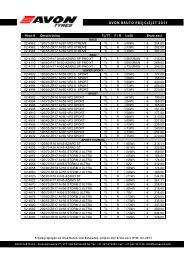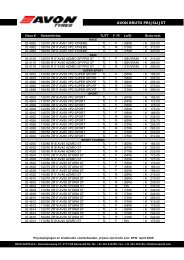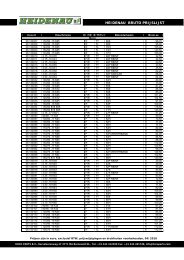You also want an ePaper? Increase the reach of your titles
YUMPU automatically turns print PDFs into web optimized ePapers that Google loves.
6<br />
7. RESERVOIR TO MASTER-<br />
CYLINDER CONNECTION<br />
7.1. Choice of tubing<br />
Black rubber tubing, compatible with brake fluid,<br />
could be used; transparent plastic tubing could also<br />
be used: The rubber tubing is the better solution, but<br />
it is not possible to see through it, and so you could<br />
not see possible air bubbles; the transparent plastic<br />
tubing is better in this sense but since it is not<br />
compatible with brake fluid, sweating could occur<br />
and so it would have to be changed periodically.<br />
7.2. Mounting<br />
The tube must connect the reservoir outlet with the<br />
master-cylinder inlet; the appropriate hose clamps<br />
must be used at both ends.<br />
8. MASTER-CYLINDER/CALIPER<br />
CONNECTION<br />
8.1. Choice of tubing<br />
a. It is suggested to use teflon flexible tubing with<br />
steel-braided covering.<br />
b. The flexible tubing must have an internal diameter<br />
of 3 mm MIN.<br />
8.2. Mounting<br />
a. Pipe fittings must be tightened to the prescribed<br />
torque.<br />
b. The copper or aluminium washers can only be<br />
used once.<br />
9. BRAKE FLUID<br />
9.1. Choice<br />
a. Use only high boiling point DOT 3 or DOT 4 brake<br />
fluids.<br />
b. Use only brake fluid from a new and sealed<br />
container.<br />
c. Change brake fluid before each race.<br />
9.2. Notes<br />
Use of liquids other than brake fluids will damage<br />
the braking system components.<br />
10. BRAKING SYSTEM BLEEDING<br />
10.1. Procedure<br />
To bleed the brakes proceed as follows:<br />
a. Turn the handlebar until the border of the reservoir<br />
is horizontal.<br />
b. Fill the reservoir with brake fluid ; during bleeding<br />
avoid letting the brake fluid level go below the<br />
MIN level.<br />
c. Apply the brakes several times to fill the braking<br />
system partially.<br />
d. Insert a flexible transparent tube to the bleed<br />
screw.<br />
e. Bleed through one bleed screw at a time:<br />
• Pull the brake lever all the way and keep it in<br />
this position;<br />
flow out (initially only air will comeout) and then<br />
tighten the bleed screw (lightly);<br />
• Let go the brake lever, wait a few seconds and<br />
repeat the above steps until no air bubbles will<br />
come out of the bleed screw.<br />
f. Tighten the bleed screw to the prescribed torque<br />
and fill up the reservoir with brake fluid.;<br />
7. COLLEGAMENTO SERBATOIO<br />
OLIO/POMPA<br />
7.1. Scelta del tubo<br />
Utilizzare il tubo in gomma nera compatibile con il<br />
fluido freni. I tubi trasparenti sono raramente<br />
compatibili con il fluido freni e se utilizzati, devono<br />
essere sostituiti periodicamente.<br />
7.2. Montaggio.<br />
Il tubo deve collegare l’uscita del serbatoio con<br />
l’entrata della pompa, appropriate fascette<br />
stringitubo devono essere utilizzate alle due<br />
estremità.<br />
8. COLLEGAMENTO POMPA/<br />
PINZA<br />
8.1. Scelta del tubo<br />
a. Suggeriamo fortemente di utilizzare tubazioni con<br />
l’interno in teflon e con l’esterno rivestito in<br />
maglia d’acciaio.<br />
b. Il diametro della tubazione interna deve essere<br />
almeno di 3 mm.<br />
8.2. Montaggio<br />
a. I bocchettoni devono essere serrati con la coppia<br />
appropriata.<br />
b. Le guarnizioni, sia in rame che in alluminio,<br />
devono essere utilizzate una sola volta.<br />
9. FLUIDO FRENI<br />
9.1. Scelta<br />
a. Utilizzare esclusivamente DOT 4 ad alto punto<br />
d’ebollizione.<br />
b. Utilizzare sempre fluido freni proveniente da<br />
confezioni nuove.<br />
c. Sostituire il fluido freni prima d’ogni gara.<br />
9.2 Note<br />
L’utilizzo di liquidi diversi dal fluido freno potrebbe<br />
provocare il danneggiamento dei componenti<br />
dell’impianto frenante.<br />
10. SPURGO IMPIANTO<br />
10.1. Procedura<br />
Per effettuare uno spurgo corretto procedere come<br />
segue:<br />
a. Girare il manubrio fino a portare il bordo del<br />
serbatoio olio in posizione orizzontale.<br />
b. Riempire il serbatoio di fluido. (Attenzione!<br />
Durante tutta la procedura di spurgo il livello olio<br />
nel serbatoio non deve mai scendere sotto il livello<br />
MIN.<br />
c. Azionare più volte la leva freno per effettuare un<br />
parziale riempimento del circuito.<br />
d. Inserire un tubo di gomma trasparente sulla vite di<br />
spurgo<br />
e. Spurgare l’impianto ripetendo quanto segue:<br />
• Tirare la leva freno completamente e mantenerla<br />
in questa posizione.<br />
• Svitare la vite spurgo e lasciare che l’olio misto<br />
ad aria fuoriesca dall’impianto.<br />
• Serrare delicatamente la vite di spurgo.<br />
dall’impianto uscirà solamente olio. Ricordiamo di<br />
rabboccare il livello olio nel serbatoio in modo che<br />
non sceda mai sotto il livello minimo.<br />
f. Serrare la vite spurgo alla coppia corretta e<br />
riempire definitivamente il serbatoio.








